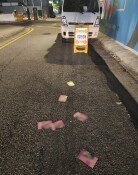Opposition to Gyeryong Rail Line Grows
Opposition to Gyeryong Rail Line Grows
Posted February. 20, 2006 03:01,
The Honam high-speed railroad line that passes through Mt. Gyeryong National Park faces opposition from civic groups, religious groups, and academic communities in Chungcheong Province.
But many are pointing out that the government should disclose the project in a transparent manner, and that civic groups should refrain from resorting to physical protests in order to prevent a second Mt. Cheonsung crisis.
Groundbreaking
The government plans to start construction work on the Honam high-speed rail line connecting Ohsong in North Chungcheong Province to Mokpo in South Jeolla Province by 2017.
When the construction is completed, the travel time between Seoul and Mokpo will be reduced from two hours and 58 minutes to one hour and 37 minutes.
According to the governments basic rail line blueprint, a 230.9km rail line will be constructed connecting Ohsong, the juncture of the Gyeongbu line, with Iksan, Gwangju, and Mokpo.
A total of 10.979 trillion won in budget money, including 732.6 billion won for purchasing trains is needed for the construction of four stations: Ohsong station, Iksan station, Songjeong-ri station (Gwangju) and Limseong-ri station (Mokpo).
The Korea Research Institute for Human Settlements announced the first phase of the plan last November.
Civic Group Opposition
The Mt. Gyeryong Civic Solidarity Group, made up of civic groups, religious groups, and academic communities, says the railroad line could destroy Mt. Gyeryong since an environmental assessment of the railroad that passes it was not conducted properly.
Citizens of Gongju argue that an intermediate station should be built at Gongju City.
Lee Jun-won (43, professor at Gongju University), the operational commissioner of Mt. Gyeryong Civic Solidarity, said, According to the blueprint, the railroad is 910km away from the national park, but the surrounding areas of the railroad where trains run at over 300 km per hour include habitats for a variety of rare animals. The governments measures, such as constructing tunnels and soundproofing walls are nothing more than stopgap measures.
Members of the civic solidarity group called for a change in the railroad line plans, but received no response from the Ministry of Construction and Transportation. They started a no-time-limit hunger strike in response at their office in Gongju on February 15.
The nearby Buddhist temples of Gapsa, Donghaksa, and Shinwonsa are also calling for changes in the railroad line, similar to the opposition movement against the Gyeongbu line near Mt. Cheonsung.
Resident Opinions Will Be Collected
The Ministry of Construction and Transportation and the Korea Research Institute for Human Settlement plan to collect resident opinions on topics such as the environmental impact of the rail line on Mt. Gyeryong and Mt. Geum, the rail line changes between Ohsong and Iksan, and the construction of Gongju station, and reflect them in the blueprint.
To that end, the Korea Research Institute for Human Settlement formed an Opinion Assessment Committee composed of five experts and five representatives from Chungcheong and Jeolla provinces to look into the points of contention.
However, as the word spreads that the government is not considering the possibility of making any changes at all, signs are emerging that the opposition movement will spread.
Han Pyeong-yong (52), vice president of the Chungnam Businessmens Association, said, According to data from the Korea Chamber of Commerce and Industry last year, National Highway 1 passing Gyeryong National Park suffered losses of 98.5 billion won due to a controversy over environmental degradation. The government should move ahead with the project in a transparent manner.
Ki-Jin Lee doyoce@donga.com




![반찬통 착색 고민 끝…‘두부용기’ 버리지 말고 이렇게 쓰세요 [알쓸톡]](https://dimg.donga.com/c/138/175/90/1/wps/NEWS/IMAGE/2026/01/09/133126593.3.png)


